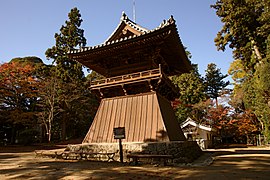Engyō-ji
The Engyō-ji ( Japanese 圓 教 寺 , also spelled 円 教 寺 in simplified form) is a temple of the Tendai direction of Buddhism on the southern slope of Mount Shosha in the north of the city of Himeji in Hyōgo prefecture . It is the 27th temple on the Saigoku Pilgrimage Route .
history
According to tradition, High Priest Shōkū ( 性 空 上人 ~ -shōnin ) laid the foundation stone in 966 on the southern edge of Mount Shosha ( 書写 山 ~ -san ). Although the temple is quite remote from Kyōto, it was not only visited by the imperial family and the nobility, but even by the emperor himself. The temple was also called " Hiei-zan of the West" and was one of the "Three Great Pilgrimage Destinations" of Tendai.
The attachment
(In the following, the symbol ◎ stands for " Important Cultural Property of Japan ".)
The temple extends with its buildings over a larger area of the southern slope of the Shosha. In the lower area is the entrance gate with the sculptures of the two temple guards, the Niō gate ( 仁王 門 ~ -mon ). Once you have passed it, you will already find some buildings of the temple complex, including the Jūmyō-in ( 十 妙 院 ) from the beginning of the Edo period . It has sliding doors inside, which were painted by Kanō Einō .
In the middle of the complex you can reach the via a longer staircase
- Mani-den ( 摩尼 殿 ), a structure that stands over supports on the slope. It was rebuilt in the Shōwa period .
- At the height of the mani is the bell tower ( 鐘楼 shoro ; ◎), further to the left the small Congo-Hall ( 金剛堂 Kongōdō ; ◎) a square layout of 3 × 3 Ken , which are here 4.88 × 4.88 m. An altar shrine ( 厨子 Zushi ; ◎) is kept in the hall.
- Higher up there is an ensemble of three buildings around a small square
- Jōgyō Hall ( 常 行 堂 ; ◎), left. It has a square floor plan of 5 × 5 Ken, which is 15.27 × 15.27 m. It houses an Amida-Nyorai ( 阿 弥陀 如 来 ) from 1005, which used to stand in the Daikō Hall.
- Refectory ( 食堂 Jikidō ; ◎), in the middle with an extension of 15 × 5 Ken, that is here 38.69 × 10.22 m. It was built on two floors at the request of Emperor Go-Shirakawa in 1174 and, with its length of almost 40 m, is unique in Japan.
- Daikō Hall ( 大 講堂 ; ◎) on the right, as the name suggests, actually the Great Teaching Hall, but here it takes on the function of the main hall ( 本 堂 Hondō ). The Daikō Hall dates from 1440 and has an area of 7 × 6 Ken when viewed from above , which is 19.52 × 16.73 m here. It has a hipped foot roof over a surrounding lower roof. Shaka-Nyorai ( 釈 迦 如 来 ) is worshiped with the saints Monju ( 文殊 菩薩 ~ -bosatsu ) and fugues ( 普賢 菩薩 ~ -bosatsu ) at his side.
You can see right at the top in the “rear area” ( 奥 の 院 Oku no in )
- the Gohōdō ( 護法 堂 ; ◎), which consists of two small Shintō shrines. The "Hall of the Temple Founder " ( 開山 堂Kaisandō ) and other buildings are also located there.
The complex includes around two dozen other temples and sub-temples, as well as the tombs of the Honda princely families and a branch of the Matsudaira .
photos
Remarks
- ↑ Mani, a Sanskrit word , means in the Buddhist walking stick .
literature
- Hyōgo-ken no rekishi sampo henshu iinkai (ed.): Engyo-ji . In: Hyogo-ken no rekishi sampo (ge) . Yamakawa Shuppan, 2012, ISBN 978-4-634-24828-1 .
Web links
Coordinates: 34 ° 53 ′ 28.1 ″ N , 134 ° 39 ′ 29.3 ″ E






